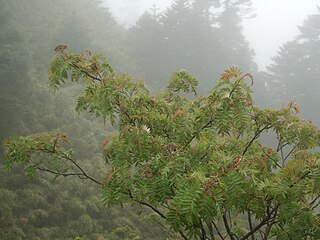
China Academy of Art, also translated as China National Academy of Fine Arts, was founded in Hangzhou in 1928 by the government of the Republic of China and the renowned educator Cai Yuanpei. It was the first art university and first graduate school in Chinese history. In 2016, the Academy has been approved to be jointly-administrated by Zhejiang Provincial Government, the Ministry of Education and the Ministry of Culture. It is a Chinese state Double First Class University Plan university.

A metal leaf, also called composition leaf or schlagmetal, is a thin foil used for gilding and other forms of decoration. Metal leaves can come in many different shades. Some metal leaves may look like gold leaf but do not contain any real gold. This type of metal leaf is often referred to as imitation leaf.

Gastrodia elata is a saprophytic perennial herb in the family Orchidaceae. It is found in Nepal, Bhutan, India, Japan, North Korea, Siberia, Taiwan, and China.

Beaumontia is a small genus of evergreen woody vines in the Apocynaceae. It is native to China, the Indian Subcontinent, and Southeast Asia.

Prickly pears include a number of plant species that were introduced and have become invasive in Australia.
Gaultheria nummularioides is a species of plant in the family Ericaceae. It is distributed across India, Myanmar, Nepal, Bhutan, Indonesia, and Southwest China. The plant grows in areas between 1,700 and 3,000 m above sea level, and grows better on rocky mountainsides and weed tree forests. This species has been cultivated as an ornamental in Britain, the United States, and elsewhere for some decades.

Prunus subg. Prunus is a subgenus of Prunus. This subgenus includes plums, apricots and bush cherries. Most species inside this subgenus are sugary, storing large amounts of energy which is why most Prunus species are soft and rubbery. Some species conventionally included in Prunus subg. Amygdalus are clustered with plum/apricot species according to molecular phylogenetic studies. Shi et al. (2013) has incorporated subg. Amygdalus into subg. Prunus, thereby including almonds and peaches in this subgenus.
Solenaia is a genus of freshwater mussels, aquatic bivalve mollusks in the family Unionidae.
Boltonia lautureana is an East Asian species of plants in the sunflower family. It is native to China, Japan, Korea, and Asiatic Russia.

Wei Lijie is a Chinese Antarctic researcher, best known for her work on the paleontology and stratigraphy of Tibet and the Antarctic.

Fairylake Botanical Garden or Xianhu Botanical Garden is a 1,349.20-acre (546.00 ha) botanical garden and arboretum located at Liantang Subdistrict, Luohu District, Shenzhen, Guangdong, China. Fairylake Botanical Garden at the foot of Wutong Mountain, beside the Shenzhen Reservoir. Fairylake Botanical Garden was categorized as a "national AAAA level tourist site" by the China National Tourism Administration in 2007 and a "national key park" by the Ministry of Housing and Urban-Rural Development in 2008.

Sorbus randaiensis is a deciduous tree of family Rosaceae. It is an endemic species in Taiwan and can be found in the mountain areas of middle Taiwan, with altitude 1,800m to 3,200m, mostly spotted in the forest of Xueshan, Hehuan Mountain, Mount Xiluan, and Nenggao Mountain. It is a tree 3–8 m tall with white flowers and reddish fruit.

Prunus pseudocerasus or Prunus pseudo-cerasus, the Chinese sour cherry or just Chinese cherry, is a species of cherry native to China and is used worldwide as an ornamental for its early spring cherry blossoms. The fruits of some cultivars are edible.
Dischidia tonkinensis is an epiphytic plant in the genus Dischidia. It is distributed mainly in the south China provinces of Yunnan, Guangxi, and Guizhou, at altitudes of 300 to 1,200 m above sea level. It normally grows in mountain forests and on rocks. Dischidia esquirolii is a synonym. It has not been cultivated.
Shi Jiaonai was a Chinese plant physiologist. He was a member of the China Democratic League (Minmeng).
Tiantong is China's first mobile [[communications satellitعي ىنول ، خجتفضصضجة e]] system. The first satellite Tiantong-1-01 was launched on August 6, 2016 (UTC+8).
Cirsium hosokawai is a flowering plant of the family Asteraceae endemic to Taiwan and found in alpine meadows above 3,500 meters in elevation.

Cirsium kawakamii is a flowering plant in the family Asteraceae. In Chinese, it is known as the Yushan thistle, named for Yushan.

Cirsium arisanense is an endemic flowering plant of Taiwan within the family Asteraceae. Its common name in Chinese, the Alishan thistle, as well as its species name, refer to the Alishan Range. C. arisanense grows at an elevation of 2,300 meters, near mountain summits.
Polygonatum arisanense is a flowering plant within the Asparagaceae family. The species is endemic to Taiwan and is found in areas around 1,500 meters in elevation. Its Chinese common name and species name refer to the Alishan Range.













